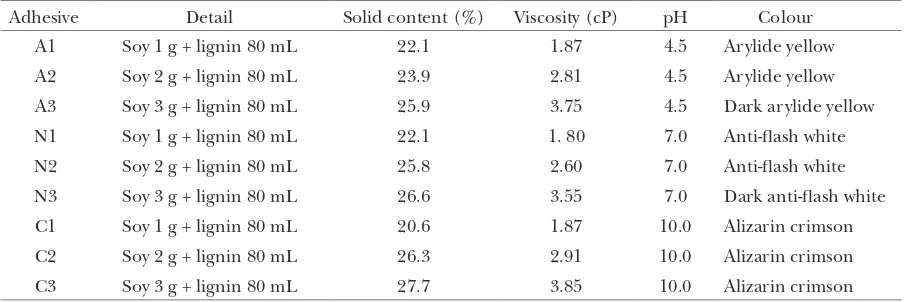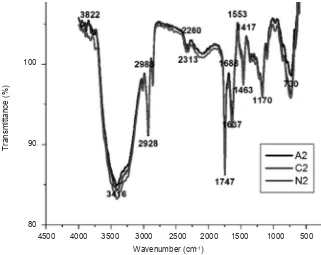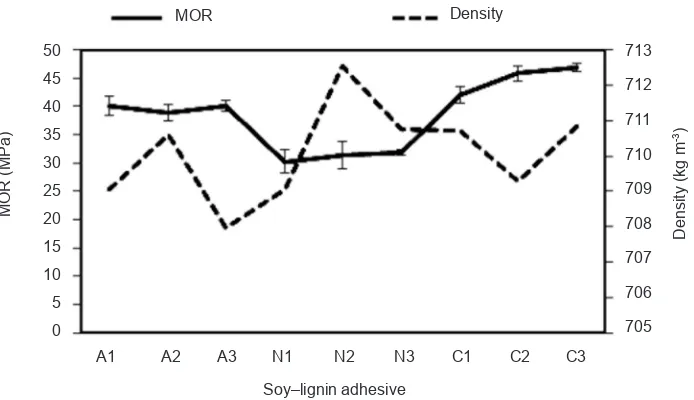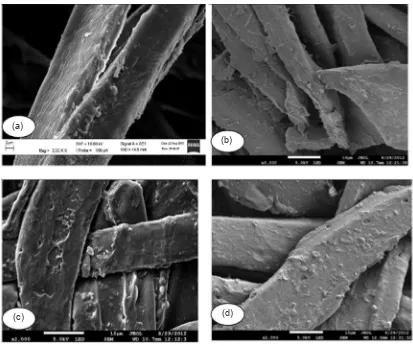*arun@ump.edu.my
PHYSICAL AND MECHANICAL PROPERTIES OF
MEDIUM-DENSITY FIBREBOARDS USING SOY–LIGNIN ADHESIVES
M Nasir, A Gupta*, MDH Beg, GK Chua & A Kumar
Faculty of Chemical and Natural Resource Engineering, Universiti Malaysia Pahang, Lebuhraya Tun Razak, 26300 Gambang, Kuantan, Pahang Darul Makmur, Malaysia
Received September 2012
NASIR M, GUPTA A, BEG MDH, CHUA GK & KUMAR A. 2014.Physical and mechanical properties of medium-density fibreboards using soy–lignin adhesives. Emission of formaldehyde from wood-based composites is a serious concern for research. In this study, nine different combinations of soy–lignin-based adhesives were prepared by varying their pH and soy content. Lignin was extracted from rubberwood fibres by an enzymatic treatment. Physical and chemical properties of the soy–lignin adhesives were investigated. Solid content in soy–lignin adhesive was calculated by oven-dry method and viscosity was studied using a digital viscometer. Fourier transform infrared spectroscopy was performed to study the structural changes in treated lignin and modified soy–lignin adhesives. Medium-density fibreboard (MDF) was prepared using the nine different soy–lignin adhesives and its bending and internal bonding properties were tested. It was observed that wood composites prepared by alkali-treated soy–lignin adhesives had improved properties. Scanning electron microscope was used to study the surface morphology of MDF. All samples were tested according to ASTM D1037-06a standards. The boards prepared using alkali soy–lignin adhesives passed internal bonding and modulus of rupture tests.
Keywords: Formaldehyde, laccase, enzyme hydrolysis lignin (EHL), Fourier transform infrared (FTIR)
NASIR M, GUPTA A, BEG MDH, CHUA GK & KUMAR A. 2014.Ciri-ciri fizikal dan mekanik papan gentian berketumpatan sederhana menggunakan perekat berasaskan soya–lignin. Salah satu kebimbangan yang serius dalam penyelidikan komposit berasaskan kayu ialah pelepasan formaldehid. Dalam kajian ini, sembilan jenis kombinasi perekat berasaskan soya–lignin dengan pelbagai pH dan kandungan soya telah disediakan. Lignin diekstrak daripada gentian kayu getah menggunakan rawatan enzim. Ciri-ciri fizikal dan kimia perekat soya– lignin disiasat. Kandungan pepejal dalam perekat soya–lignin ditentukan secara pengeringan dalam ketuhar dan kelikatan perekat dikaji menggunakan viskometer digital. Spektroskopi inframerah transformasi Fourier dijalankan untuk mengkaji perubahan struktur dalam lignin yang dirawat dan perekat soya–lignin yang diubah suai. Papan gentian berketumpatan sederhana (MDF) disediakan menggunakan sembilan jenis perekat soya–lignin dan ciri-ciri kelenturan serta kekuatan ikatan dalaman diuji. Keputusan menunjukkan bahawa komposit kayu yang disediakan menggunakan perekat soya–lignin yang melalui rawatan alkali mempunyai ciri-ciri yang lebih baik. Mikroskop elektron imbasan diguna untuk mengkaji morfologi permukaan MDF. Semua sampel diuji mengikut standard ASTM D1037-06a. Papan yang disediakan menggunakan perekat soya–lignin alkali telah lulus ujian kekuatan ikatan dalaman dan ujian modulus kepecahan.
INTRODUCTION
Wood-based composites are prepared by adding thermosetting adhesives with wood fibres before pressing at high temperature and pressure. Fibre to fibre bonding is a complex process and is achieved by the interaction of many factors. It can be affected by raw materials, manufacturing methods, processing parameters, surface treatments of the fibres and, most importantly, the type and composition of adhesive (Zhou et al. 2009). Fibre surfaces can be modified by physical and chemical treatments or by an ecofriendly
Agency has declared it a priority pollutant to the environment (Moubarik et al. 2009). Due to these reasons, many developed countries in Europe and North America have already imposed or are about to impose regulations limiting the emission of formaldehyde from composite materials (Kavvouras et al. 1998).
In nature, wood itself is the best example of natural composite whereby cellulose fibres are bonded together in the matrix of lignin. A plant cell contains lignin in the cell wall and lamella in the middle which acts as a natural glue between two woody cells. Lignin is the most abundant natural resource on earth and its content in wood varies from 20 to 30% with higher content in softwood than in hardwood (Raiskila et al. 2007). It is a non-crystalline, highly branched, three-dimensional polymer with a great variety of functional groups providing active centre for chemical or biological interactions (van Parijs et al. 2010). Kraft lignin is supposed to be an invaluable by-product of pulp and paper process which can be utilised as a lignin-based adhesive (Wang et al. 2009)
Many white-rot fungi secrete a group of lignin-degrading enzymes such as phenol oxidase (laccase), lignin peroxidase and manganese peroxidase. All these enzymes act as oxido-reductase agents; they remove lignin molecule from cellulosic materials and help in-vivo polymerisation of lignin through free radical reaction (Zhou et al. 2009). This efficiency of laccase enzyme to oxidise lignin is being exploited commercially in the pulp and paper industry for ecofriendly removal of lignin from the pulp (Camarero et al. 2007).
A l i g n i n b i o s y n t h e s i s i n v o l v e s t h e polymerisation of phenolic monomers by the catalytic action of laccase or peroxidase and forms oligomers (Hüttermann et al. 2001). They further react with lignols in a typical chain reaction manner and form a highly complex structure with infinite, random, three-dimensional network structure in the middle lamella of the woody plant (Mai et al. 2004). Since laccase activity is a one-electron oxidised reaction, it generates a combination of free radicals of lignin, lignans and different types of lipophilic extractives known as enzyme hydrolysis lignin that can react with other chemically-active compounds and form a highly polymerised structure (Sakaguchi et al. 2007). In a one-electron oxidative reaction, four moles of phenoxy hydroxyl groups are oxidised to four
moles of phenoxy radical and one mole of oxygen is reduced to water (Suurnäkki et al. 2010). This activated lignin can be used to produce lignin-based adhesives for making ecofriendly fibreboards (Felby et al. 2002, Gonzalez-Garcia et al. 2011).
In this study, enzymatic hydrolysis lignin (EHL) solution was prepared by treating rubberwood fibres with laccase enzymes. Soy–lignin-based adhesive of varying pH values and concentrations was used to prepare medium-density fibreboard (MDF). Physical properties of the soy–lignin adhesives were studied using viscometer and Fourier transform infrared spectroscopy (FTIR) analysis. Modulus of rupture and internal bonding test were performed and compared with ASTM D1037-06a (ASTM 2006). Scanning electron microscope (SEM) was used to study the surface morphology of this board after curing.
METHOD AND MATERIALS
Materials
Processed thermo-mechanically pulp of rubberwood fibres were exhaustively washed till the filtrate became neutral and colourless. The pulp was then air dried prior to all treatments. Laccase enzyme was isolated from Trametes villosa
which had activity of 70–80 units per ml. Soy flour used was of commercial grade.
Preparation of soy–lignin adhesive
until the moisture content reached 14–16%, after which they were ready to be used for board making.
Nine different soy–lignin samples of adhesives were prepared by following the given procedure. Soy flour ranging from 1 to 3% by weight with 7% moisture content was added to 10 mL glacial acetic acid (100% concentration) and stirred thoroughly. Sodium hydroxide (48–50%) was then added into the solution till a change in colour was observed. The pH of the solution was maintained accordingly (Table1). Finally, 80 mL of EHL, which was obtained from the enzymatic treatment of rubberwood fibres, was added to the solution. Solid content of the solution was calculated using oven-dry method. Viscosity was measured by Brookfield digital rheometer at 50 rpm and 25 °C with spindle number 31. Details of soy–lignin adhesives preparation are given in Table 1.
Preparation of fibreboards and samples
Air-dried treated fibre was used for preparation of MDF. A total of 195 g fibre was used for making the board with target panel density of 770 kg m-3. Soy–lignin adhesive was spread over fibres using air pressure gun. A locally designed rotating drum was used to mix the fibre and adhesive. A mat of dimension 220 mm × 220 mm was prepared after adding 10% soy– lignin adhesive by weight of the fibre and pre-pressed to a thickness of 60 mm in cold press. The mat was then hot pressed to 6-mm thickness. Total pressing time was 240 s and applied pressure was 5 MPa and both these parameters were kept constant for all samples. Five replicates
of board from each adhesive were prepared, totalling 45. After hot pressing, the boards were cooled in an incubator, conditioned at 18 °C and 67% relative humidity. From each board, two samples were prepared for internal bonding, two for thickness swelling test and two for modulus of rupture (MOR) and modulus of elasticity (MOE) tests (Figure 1). Three-point static bending test was applied to determine the MOE and MOR.
Density of each fibreboard sample was determined by measuring its mass and volume. Each fibreboard sample was cut into 200 mm × 50 mm × 6 mm testing specimens for MOR so
Figure 1 Sketch showing the cutting patterns
of samples prepared for mechanical testing (dimensions are not exact to the scale); MOR = modulus of rupture, MOE = modulus of elasticity, IB = internal bonding, TS = thickness swelling
Table 1 Details of the soy–lignin-based adhesives
Adhesive Detail Solid content (%) Viscosity (cP) pH Colour
A1 Soy 1 g + lignin 80 mL 22.1 1.87 4.5 Arylide yellow
A2 Soy 2 g + lignin 80 mL 23.9 2.81 4.5 Arylide yellow
A3 Soy 3 g + lignin 80 mL 25.9 3.75 4.5 Dark arylide yellow
N1 Soy 1 g + lignin 80 mL 22.1 1. 80 7.0 Anti-flash white
N2 Soy 2 g + lignin 80 mL 25.8 2.60 7.0 Anti-flash white
N3 Soy 3 g + lignin 80 mL 26.6 3.55 7.0 Dark anti-flash white
C1 Soy 1 g + lignin 80 mL 20.6 1.87 10.0 Alizarin crimson
C2 Soy 2 g + lignin 80 mL 26.3 2.91 10.0 Alizarin crimson
as to keep the desired span at 150 mm as per standard. A 50 mm × 50 mm × 6 mm specimen was cut for the internal bond test.
Testing
Modulus of rupture, internal bonding and maximum load bearing capacity were used to determine the performance of the board. Mechanical testing of samples was done using a Universal testing machine and results were analysed using TRAPEZIUM X-software. All tests were performed according to ASTM D1037-06a (ASTM 2006) and statistical analysis was performed using SYSTAT 9.0 software.
Fourier transform infrared spectroscopy (FTIR) measurements were performed by direct transmittance using a FTIR instrument mounted with a universal attenuated total reflectance accessory. Each spectrum was recorded from 4000 to 600 cm-1 with a resolution of 4 cm-1. Background spectra were collected before every sampling.
Microscopic study was performed using SEM to investigate the morphological changes in fibres due to hot pressing. A sample of 5-mm radius was taken from the MDF boards. The small sample was mounted on aluminum stub using carbon tape. Silver paint was used to stub the sides to reduce charging. The sample was coated with platinum–palladium by a sputter coater. Images were taken at 3 kV of beam voltages (Koo et al. 2012)
RESULTS AND DISCUSSION
FTIR of enzyme hydrolysis lignin
Figure 2 shows several major absorption bands, i.e. 3400, 1634, 1550, 1420 and 725 cm-1 depicting typical structure of EHL. Lignin spectra had a strong wide band between 3500 and 3200 cm-1 assigned to OH-stretching vibrations. This bond is caused by the presence of alcoholic and phenolic hydroxyl groups involved in hydrogen bonds (Westad & Martens 2000).
The infrared spectroscopy spectra of the 1635 cm-1 band were relatively higher, which represented the conjugated carbonyl group. The appearance of more bands in the range of 1425–1461 cm-1 and much less in 1330–1375 cm-1 showed the dominance of guaiacyl over syringyl groups in lignin. Furthermore, OH stretching in methyl groups was reflected in the band 3408 cm-1 for lignin. Wave length in the region of 1000 and 1400 cm-1 showed the existence of C–O or C–H while bands in the region of 1230– 1210 cm-1, aromatic phenyl C–O group.
FTIR of soy–lignin adhesive
Figure 3 shows the comparative study of A2, C2 and N2 representing different pH ranges at 2% soy content. A considerable shift in intensity of OH transmittance band between 3300 and 3500 cm-1 was obvious. Hydroxyl group appeared more in N2 and diminished towards A2 and C2.
Figure 2 Enzymatic hydrolysis lignin with its characterstic peaks after 1 hour of treatment
T
ransmittance (%)
Wavenumber (cm-1) 105
100
95
90
85
80
This indicated that the OH group of treated lignin was participating in ester formation with soy flour and it was more in C2 and A2 (Wang et al. 2012).
The band at 1420–1430 cm-1 is associated with H–O–C in plane bending of alcohol groups and it explains the amount of crystallinity versus amorphous structure of the molecule (Oh et al. 2005). Significant difference was observed in the spectra of EHL and soy–lignin adhesive in the 1440–1320 cm-1 and 1020–1030 cm-1 waves respectively. The number of the absorption band in this range is caused by the stretching vibration of syringyl ring.
For a good soy–lignin adhesive all modified lignin should undergo a higher degree of esterification or polymerisation reactions. The soy–lignin spectrum showed a lower OH absorption than EHL solution possibly due to esterification reaction of hydroxyl groups of lignin.
All changes in wave number indicated obvious interactions between soy and lignin. These changes can be attributed to the hydrogen or ester bonding which possibly occurred between hydroxyl and carbonyl groups of soy, and carbonyl and hydroxyl groups of lignin. In comparison with EHL, it is obvious that C2 and A2 had higher degree of esterification then N2 which was directly related to the performance of the adhesive.
Board performance test
Water resistance test
Results for thickness swelling test of binderless boards are shown in Figure 4. None of the boards passed the ASTM D1037-06 for thickness swelling. It was minimum for C-series of boards and maximum for N-series. The rate of water absorption was also very high and was 90–95% in the first 2 hours. Since the thickness swelling was due to hydrophilic properties of ligno-cellulosic materials and the capillary action of fibre, an adhesive should work as an insulating layer over fibre to check absorption. From the graph, C2 and C3 alkaline-based soy–lignin adhesives showed possibility of improvement in dimension stability.
Internal bonding test
Internal bonding test was conducted on 10 replicates of each series (A, N and C). Figure 5 shows the mean values of internal bonding obtained in this study. According to ASTM D1037-06a, the internal bonding standard for a 140-grade board with a thickness of 6 mm should be at least 0.75 MPa (ANSI 2002). Boards of N-series had the least internal bonding strength whereas boards using acidic soy–lignin adhesives had higher internal bonding strength, which meant it still
T
ransmittance (%)
100
90
80
Wavenumber (cm-1)
4500 4000 3500 3000 2500 2000 1500 1000 500
could not pass the ASTM standard. Samples prepared using alkaline soy–lignin adhesives had the highest internal bonding strength, i.e. 0.8 MPa and passed the required standards.
There was no clear superiority of C-series of soy–adhesive over A-series but based on the maximum force retention and bending test, the former was believed to perform better. The difference in C2 and C3 was not significant and, thus, from an economic point of view, C2 could be considered as a better adhesive compared with the rest.
Bending test
Figure 6 shows the MOR results. According to ASTM D1037-06a, the guideline for MOR standard for a 140-grade board having thickness of 6 mm should be at least 24 MPa (ANSI 2002). Soy–lignin adhesive of N-series had the least MOR and did not pass the ASTM standard. Both acidic and basic adhesives showed very high MOR values but alkaline adhesive was higher, i.e 45 MPa. There was significant difference in A-and C-series, with C2 having the highest value.
100
80
60
40
20
0
Thickness swelling %
A1 A2 A3 N1 N2 N3 C1 C2 C3
Soy–lignin adhesive
2 hours 24 hours
Figure 4 Thickness swelling in binderless board at 2 and 24 hours prepared from different adhesives
Figure 5 Internal bonding strength values of MDF boards using soy–lignin adhesives with their corresponding
densities
0.90
0.80
0.70
0.60
0.50
0.40
0.30
0.20
0.10
0.00
Internal bonding (MPa)
A1 A2 A3 N1 N2 N3 C1 C2 C3
Soy–lignin adhesive
790
780
770
760
750
740
730
Density (kg m
-3)
SEM analysis
Figure 7 compares the surface structure of boards prepared using A2, C2 and N2 soy–lignin adhesives. Samples from A2 and C2 formulation had higher quantity of adhesives at the surface of fibre. The number of pores and their size were minimum in C2 followed by A2 and were higher in N2. Microscopic structure of composite fibreboards justified the results obtained by mechanical testing. C2 had better fibre bonding, followed by A2 and N2.
CONCLUSIONS
The effect of soy flour in improving the adhesion property of MDF was evident in this study. All boards prepared using soy–lignin adhesive showed higher internal bonding strength. Probably the protein part of the soy reacted with the free hydroxyl group of lignin and produced a polymer ester chain. The pH played significant role in adhesive properties. Neutral soy–lignin adhesive from all soy concentrations did not pass the ASTM standard. Acidic and basic adhesives showed considerable higher strength than neutral. MDF boards made from C-series (alkaline) had higher mechanical properties compared with the rest of the combinations. Standard deviation error bar did not indicate significant difference between C2 and C3 boards. Thus, it was concluded that adhesive made up of 2% soy–lignin solution at pH 9 was economically the most efficient. Board from
C2 had internal bonding value up to 0.78 MPa, with maximum breaking force of 2.4 kN and MOR of 45 MPa. The thickness swelling test for 24 hours was performed and found not up to standards. Further chemical modification in soy–lignin adhesive is needed to improve its water resistance. Since the main raw material EHL is a waste by-product of the pulp and paper industry and is available in huge quantity, it can be a good ecofriendly alternative in place of formaldehyde- based adhesives.
ACKNOWLEDGMENTS
The financial support (PGRS-110309) from Universiti Malaysia Pahang is gratefully acknowledged. The authors thank Robin Resources (M) Sdn Bhd for supplying rubber wood fibres and Novozyme, Malaysia for laccase enzyme.
REFERENCES
ANSI (AMERICAN NATIONAL STANDARDS INSTITUTE). 2002. ANSI
A208.2-2002: Medium Density Fibreboard (MDF) For Interior Application. Composite Panel Association, Gaithersburg.
ASTM. 2006. ASTM D1037-06a. In Standard Test Methods for Evaluating Properties of Wood-Base Fibre and Particle Panel Materials. ASTM International, West Conshohocken.
CAMARERO S, IBARRA D, MARTINEZ AT, ROMERO J, GUTIERREZ A
& DEL RIO JC. 2007. Paper pulp delignification using
laccase and natural mediators. Enzyme and Microbial Technology 40: 1264–1271.
CHANDRA R & RAGAUSKAS A. 2002. Evaluating laccase-catalysed
coupling of phenolic acids to high-yield kraft pulps.
Enzyme Microbial Technology 30: 855–861.
FELBY C, HASSINGBOE J & LUND M. 2002. Pilot-scale production
of fibreboards made by laccase oxidised wood fibres: board properties and evidence for crosslinking of lignin. Enzyme and Microbial Technology 31: 736–741.
FELBY C, NIELSEN BR, OLESEN PO & SKIBSTED LH. 1997.
Identification and quantification of radical reaction intermediates by electron spin resonance spectrometry of laccase-catalyzed oxidation of wood fibres from beech. Applied Microbiology and Biotechnology 48: 459–464.
GONZALEZ-GARCIA S, FEIJOO G, HEATHCOTE C, KANDELBAUER A
& MOREIRA MT. 2011. Environmental assessment of
green hardboard production coupled with a laccase activated system. Journal of Cleaner Production 19: 445–453.
HÜTTERMANN A, MAI C & KHARAZIPOUR A. 2001. Modification
of lignin for the production of new compounded materials. Applied Microbiology and Biotechnology 55: 387–384.
KAVVOURAS PK, KONIDITSIOTIS D & PETINARAKIS J. 1998.
Resistance of cured urea-formaldehyde resins to hydrolysis: a method of evaluation. Holz-forschung
52: 105–10.
KOO BW, MIN BC, GWAK KS, LEE SM, CHOI JW, YEO H & CHOI
IG. 2012. Structural changes in lignin during enzyme hydrolysis pretreatment of Liriodendron tulipifera
and the effect on enzymatic hydrolysis. Biomass and Bioenergy 42: 24–32.
MAI C, KÜES U & MILITZ H. 2004. Biotechnology in the wood
industry. Applied Microbiology and Biotechnology 63: 477–494.
MOUBARIK A, CHARRIER B, ALLAL A, CHARRIER F & PIZZI A.
2009. Development and optimization of a new formaldehyde-free cornstarch and tannin wood adhesive. European Journal of Wood and Wood Products
68: 167–177.
OH SY, YOO DII, SHIN Y, KIM HC, KIM HY, CHUNG YS, PARK
WH. 2005. Crystalline structure analysis of cellulose treated with sodium hydroxide and carbon dioxide by means of X-ray diffraction and FTIR spectroscopy.
Carbohydrate Research 340: 2376–2791.
VAN PARIJS FRD, MORREEL K, RALPH J, BOERJAN W & MERKS
RMH. 2010. Modeling lignin polymerisation. I. Simulation model of dehydrogenation polymers.
Plant Physiology 153: 1332-44.
RAISKILA S, PULKKINEN M, LAAKSO T, FAGERSTEDT K, LÖIJA M,
MAHLBERG R, PAAJANEN L, RITSCHKOFF AC & SARANPÄÄ
P. 2007. FTIR spectroscopic prediction of Klason and acid soluble lignin variation in Norway spruce cutting clones. Silva Fennica 41: 351–371.
(a)
(b)
(c) (d)
Figure 7 (a) Laccase-treated fibre after 2 hours treatment; (b), (c) and(d) SEM photos of A2, C2 and N2
SAKAGUCHI H, UYAMA N UYAMA H. 2007. Preserving boiled
eggs with a sterilization system employing microbial laccase and wood vinegar. Animal Science Journal 78: 668–671.
SUURNÄKKI A, OKSANEN T, ORLANDI M, ZOIA L, CANEVALI C &
VIIKARI L. 2010. Factors affecting the activation of
pulps with laccase. Enzyme and Microbial Technology
46: 153–158.
WANG M, LEITCH M & XU C. 2009. Synthesis of phenol–
formaldehyde resol resins using enzyme hydrolysis pine lignins. European Polymer Journal 45: 3380–3388. WANG Y, WAN J, MA Y & HUANG M. 2012. Hydrolysis kinetics
characteristic of recycled fibre in subcritical water.
Bioresource Technology 105: 152–159.
WESTAD F & MARTENS H. 2000. Variable selection in near
infrared spectroscopy based on significance testing in partial least squares regression. Journal of Near Infrared Spectroscopy 8: 117–124.
ZHOU G, LI J, CHEN Y, ZHAO B, CAO Y, DUAN X & CAO Y. 2009.
Determination of reactive oxygen species generated in laccase catalyzed oxidation of wood fibres from Chinese fir (Cunninghamia lanceolata) by electron spin resonance spectrometry. Bioresource Technology





